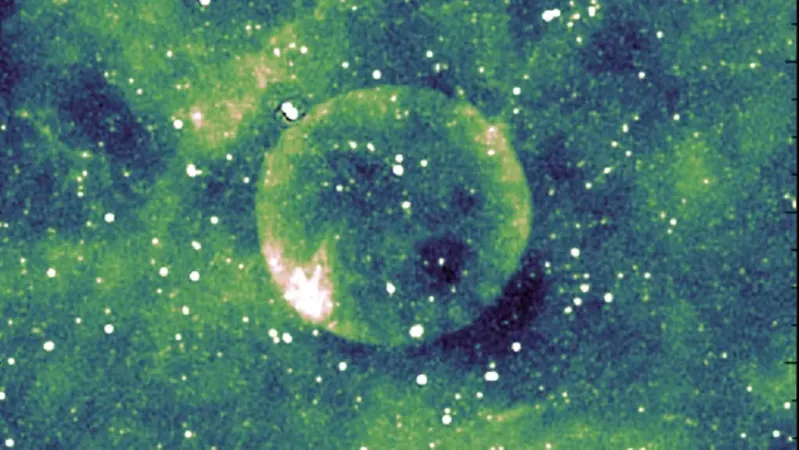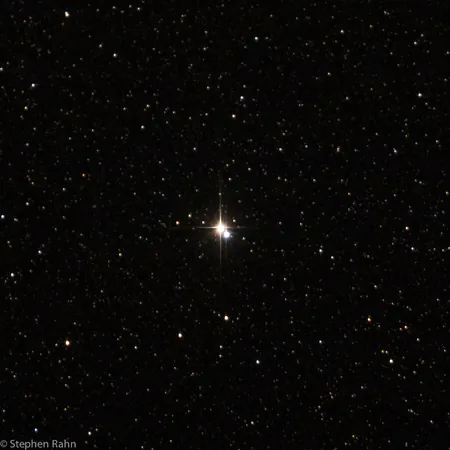
Mysterious Sphere Named Teleios Discovered in the Milky Way: A Cosmic Enigma
2025-06-03
Author: Li
Astronomers Stunned by Celestial Mystery
In a groundbreaking discovery, scientists are grappling with a perfectly spherical object, dubbed Teleios, that floats silently in the Milky Way, solely emitting radio signals. This cosmic enigma has left researchers questioning how such a round form can exist in the depths of space.
Teleios: A Beacon of Weirdness
Discovered by a team led by Professor Miroslav D. Filipović of Western Sydney University, Teleios first caught attention when Australia’s ASKAP telescope detected faint radio waves from a remarkably circular area of our galaxy. Strikingly, this object gives off no visible light, infrared radiation, or X-ray emissions, making classification a monumental challenge.
Is Teleios a Young Supernova or an Ancient Remnant?
Located thousands of trillions of miles from Earth, Teleios seems to be expanding, its symmetrical shape defying many existing theories of celestial formation. Speculation suggests it could either be an ancient star remnant or a youthful supernova cast from an explosion. Its colossal diameter of potentially 157 light-years indicates that it has been growing for an extensive time, but the precise timeline of its existence remains a mystery.
Soft Radio Signals and Unusual Characteristics
Experts describe Teleios as possessing low surface brightness, implying that its energy output is distributed thinly across its vast surface. The radio glow detected by ASKAP is reminiscent of supernova remnants, but the perfect symmetry prompts a reevaluation of standard assumptions. Notably, Teleios has never been observed across any visible wavelengths, highlighting the crucial role of radio telescopes in uncovering elusive cosmic entities.
Challenges to Current Astrophysical Theories
Established theories about supernova remnants frequently depict them as distorted due to uneven gas and debris dispersal. If Teleios is indeed a remnant, its smoothness hints at an unusually calm environment devoid of interference. Some scientists propose it might even be a massive 'bubble' shaped by stellar winds.
Could This Change Our Understanding of Supernovae?
Teleios’s peculiar characteristics put it at odds with known supernova debris catalogs. If it formed recently, X-ray emissions would typically be expected; however, its absence of such signals raises complex questions about its true nature. Experts speculate that Teleios may represent a novel type of supernova—one that challenges our understanding of stellar explosions.
A Unique Environment for Cosmic Evolution
Researchers contemplate that Teleios’s uniform shape could stem from having evolved in a quiet corner of space, with a low density of gas allowing for unimpeded radial expansion. There’s also speculation regarding a white dwarf star playing a role in its formation.
Mapping the Universe's Mysteries
The ASKAP telescope's southern sky survey aims to construct an Evolutionary Map of the Universe, possibly revealing more structures like Teleios. Finding additional similar objects could force scientists to rethink their understanding of how cosmic bubbles behave.
The Mystery of Teleios Is Just Beginning to Unfold
Despite advancements, no concrete evidence distinctly categorizes Teleios, leaving an array of questions unanswered. Researchers are eager to conduct follow-up observations to monitor any changes in Teleios and to further explore its enigmatic characteristics. As our tools and understanding of the cosmos enhance, the secrets of Teleios may begin to unravel.




 Brasil (PT)
Brasil (PT)
 Canada (EN)
Canada (EN)
 Chile (ES)
Chile (ES)
 Česko (CS)
Česko (CS)
 대한민국 (KO)
대한민국 (KO)
 España (ES)
España (ES)
 France (FR)
France (FR)
 Hong Kong (EN)
Hong Kong (EN)
 Italia (IT)
Italia (IT)
 日本 (JA)
日本 (JA)
 Magyarország (HU)
Magyarország (HU)
 Norge (NO)
Norge (NO)
 Polska (PL)
Polska (PL)
 Schweiz (DE)
Schweiz (DE)
 Singapore (EN)
Singapore (EN)
 Sverige (SV)
Sverige (SV)
 Suomi (FI)
Suomi (FI)
 Türkiye (TR)
Türkiye (TR)
 الإمارات العربية المتحدة (AR)
الإمارات العربية المتحدة (AR)